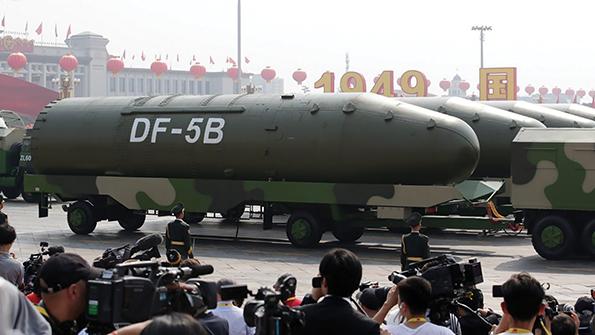
Air Force Secretary Frank Kendall has warned that China may seek to revive a 55-year-old concept for a missile that can deliver a nuclear payload from space or near-space on a “back door” trajectory via the Southern Hemisphere.
The sudden warning made on Sept. 20 at the Air Force Association’s (AFA) 2021 Air, Space & Cyber Conference adds to a staggering list of warnings and disclosures over the last three months by the Biden administration. During that period, officials and open sources have revealed new details about China’s nuclear ambitions, which include a nuclear-powered cruise missile, accelerated warhead production and newly built fields of hundreds of silos for intercontinental ballistic missiles (ICBM) (AW&ST Sept. 13-26, p. 16).
“They have gone from a few high-value assets near China’s shores to the second and third island chains, and most recently to intercontinental ranges and even to the potential for global strikes from space,” Kendall said in his keynote address.
Kendall’s statement immediately raised eyebrows. Although U.S. think tanks and intelligence agencies have warned repeatedly that China is developing the means to attack satellites in space, there had been no recent suggestions of Chinese intent to stage nuclear attacks on Earth from space.
The truth, as Kendall later elaborated, is only slightly less dramatic but does reveal yet another glimpse into the intelligence warnings about China’s potential nuclear ambitions. In fact, Kendall said his remark about “global strikes from space” was a reference to a possible revival by China of a Cold War-era concept called a Fractional Orbital Bombardment System (FOBS).
“If you use that kind of approach, you don’t have to use a traditional ICBM trajectory, which is directly from the point of launch to the point of impact,” Kendall told journalists after his speech. “It’s a way to avoid defenses and missile warning systems.”
A FOBS uses a multistage, orbital-class launcher with a nuclear or conventional payload, but the missile does not complete a full orbit. Previously known concepts instead had the booster reaching an altitude of 90-150 km (56-93 mi.)—just below and above the Karman Line at 100 km. The last stage of the booster would fire a retrorocket before completing a full orbit, allowing the payload to reenter the atmosphere on an unpredictable trajectory.
In a sense, a FOBS offers a similar capability as an ICBM-range hypersonic glide vehicle (HGV). An HGV, such as Russia’s nuclear Avangard, uses cross-range maneuvers to duck under and swerve around missile warning systems and obscure its intended target until the last moments.
The FOBS concept is often linked to a failed program by the Soviet Union in the 1960s but also has a little-known pedigree in China from the same era.
In 1992, two Stanford University professors-—John Lewis and Hua Di, the latter a Soviet-trained member of China’s ballistic missile program—described China’s canceled FOBS program in the quarterly journal International Security. A FOBS feasibility study ordered by Chinese Premier Zhou Enlai in 1965 proposed a new, three-stage variant of the then-developmental Dong Feng-5 (DF-5) ICBM.
The FOBS version of the DF-6 “could strike the U.S. homeland from the south, flying over the Antarctic and penetrating the weakest points in the American warning network,” Lewis and Hua wrote. By 1973, however, “an endless chain of technical problems intervened and forced the cancellation of the DF-6.”
Nearly 50 years later, it is not clear what Chinese activity prompted Kendall’s remarks at the AFA’s largest event. U.S. intelligence officials have said that China has staged more tests of new ballistic missiles than the rest of the world combined since 2019, but they offered no granular details about the types of capabilities being tested on China’s remote western ranges.
Since his Senate swearing-in ceremony in August, Kendall has received classified updates on U.S. intelligence assessments of China’s military capabilities, providing a refresh for the career national security bureaucrat after a four-year stint outside government service.
“I’ve had the opportunity to catch up on the intelligence about China’s modernization programs,” Kendall said. “If anything, China has accelerated its pace of modernization, and [that is] taking [them] in some disturbing directions.”
Editor's note: This article has been updated to correct the altitude of the Karman Line.





Comments
Second, there are people in America who continue to use the phrase that, "Everything is on the table.", with respect to a possible armed conflict with China. This is an implied threat to use nuclear weapons. The Chinese know that the only way to deter this possibility is to have nuclear forces large enough to make American decision makers recognize the folly of such an idea.